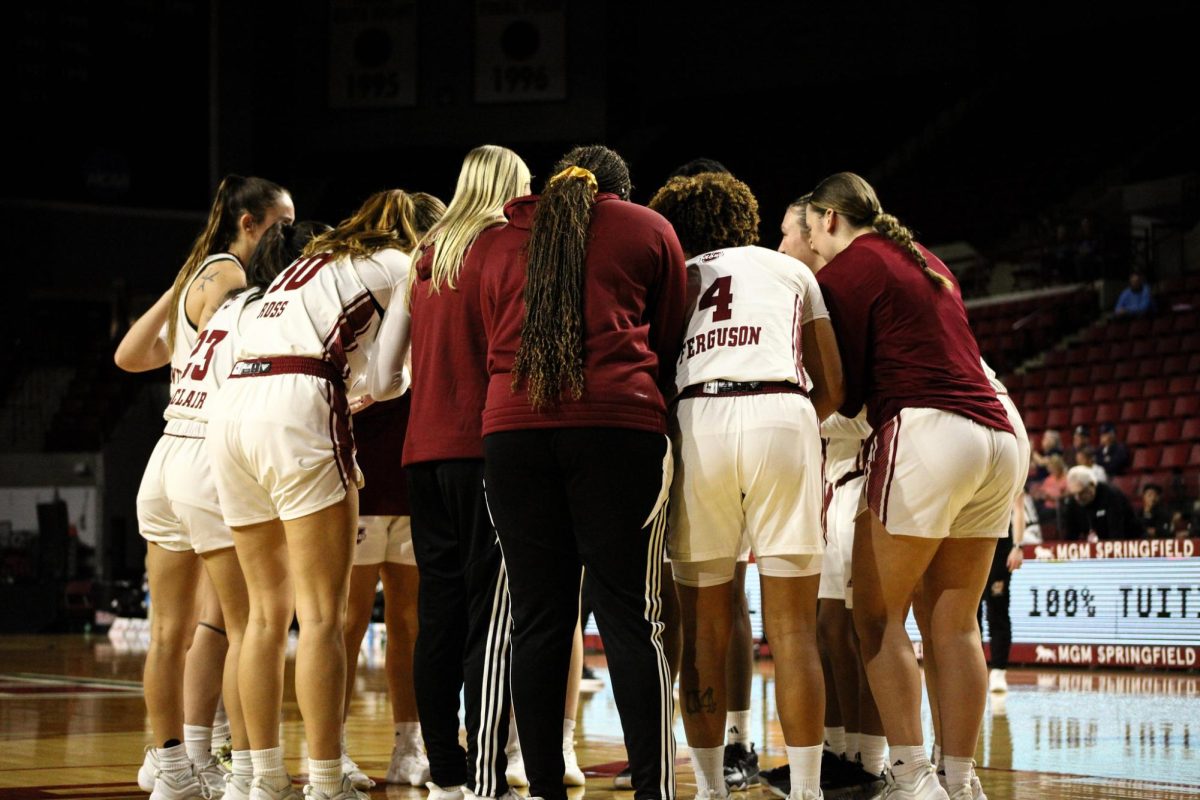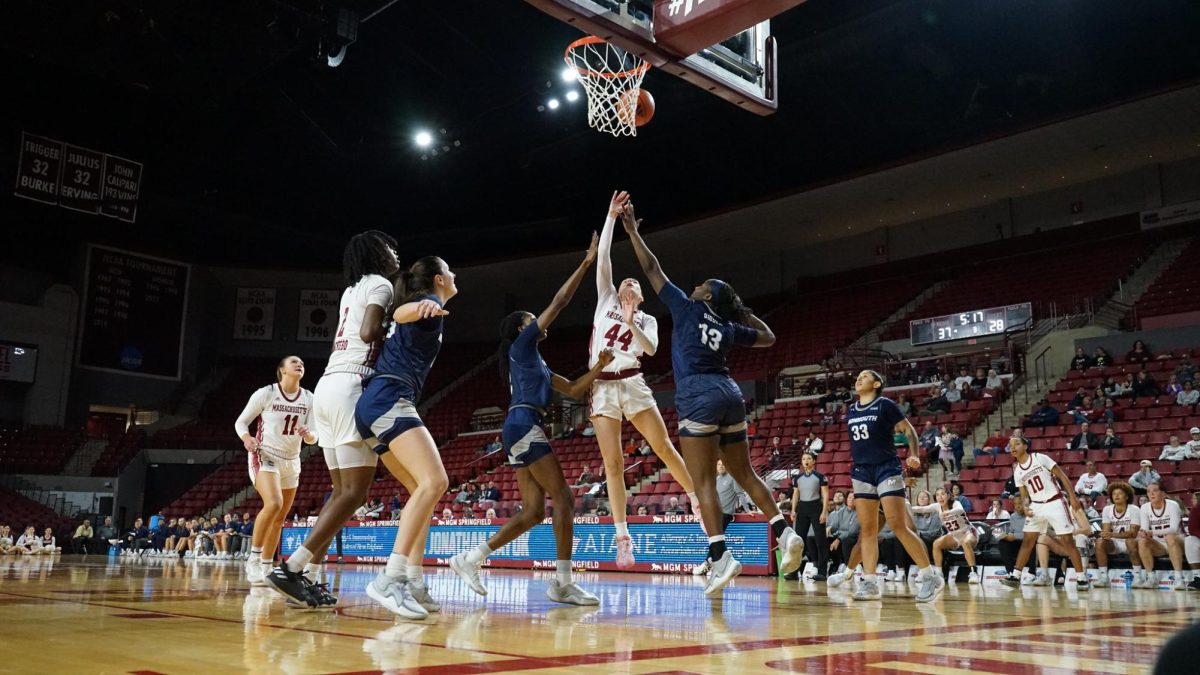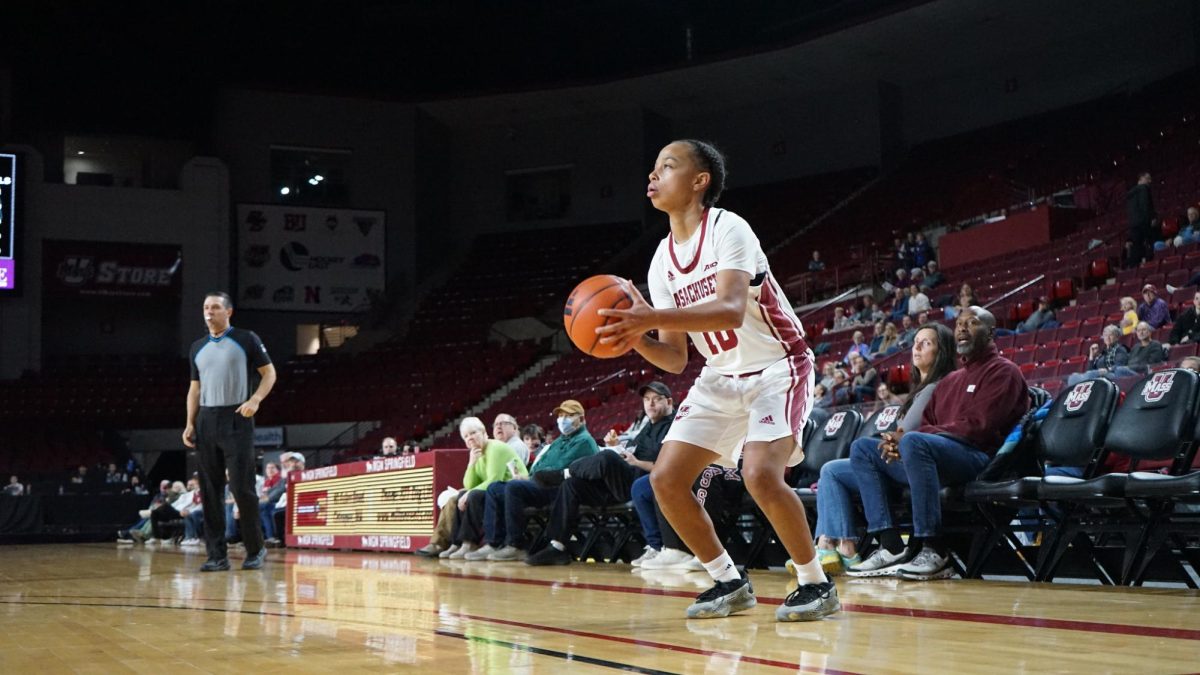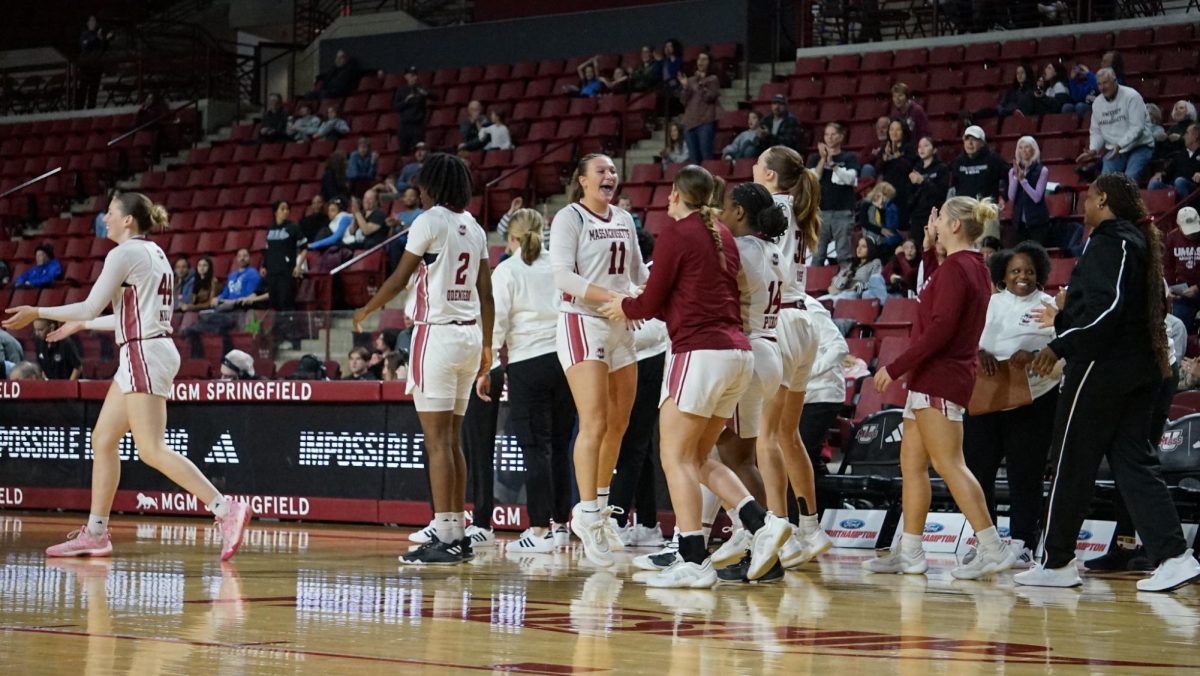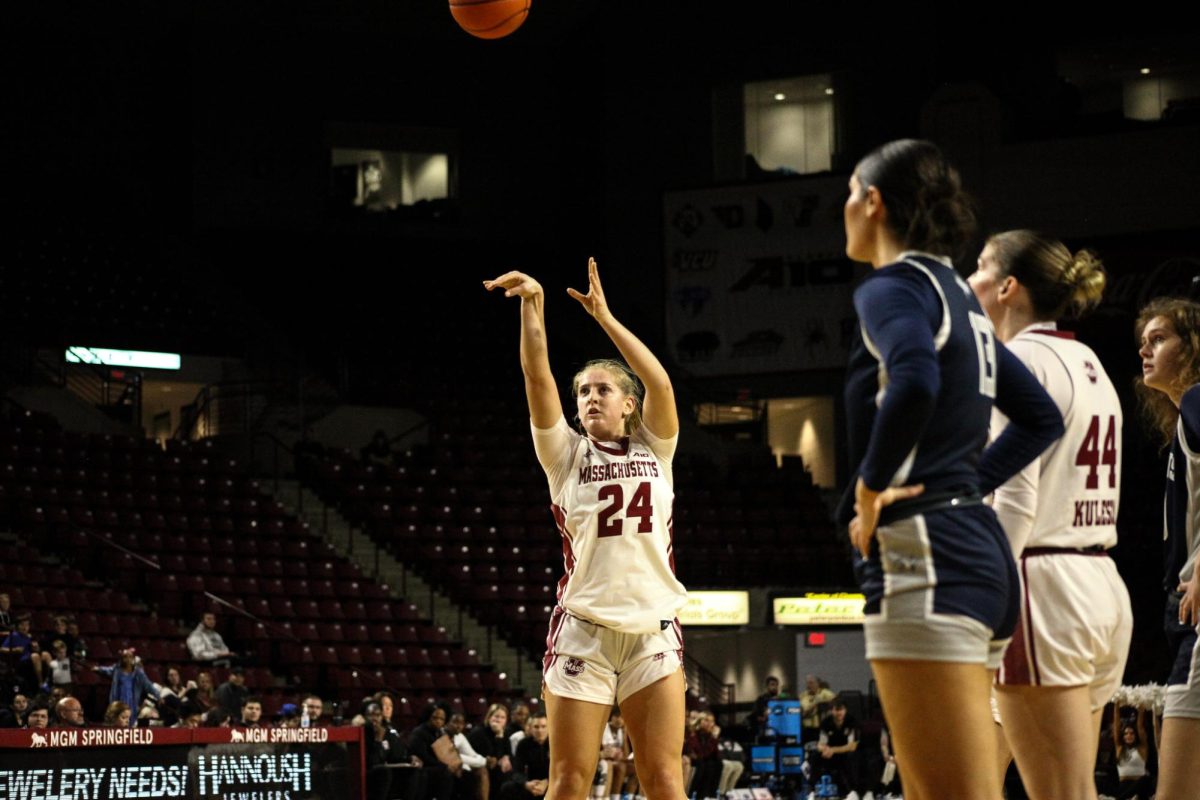Cerie Mosgrove’s got a fever and the only prescription is more 3-pointers.
It’s something that’s carried her through her college career and came to a culmination on March 31 in Houston, Texas, where Mosgrove had been invited to the 2011 State Farm Women’s 3-Point Shooting Championship.
“[It’s] kind of like an addiction,” she said.
The senior guard from Massachusetts, which was knocked out of the first round of the Atlantic 10 Tournament by Charlotte back on March 4, didn’t think she would ever don the Maroon and White again until she got the invitation over a week after the Minutewomen had been eliminated. On March 31, though, Mosgrove was set to face off against seven of the nation’s best 3-point shooters, all of whom represented schools that participated in the NCAA tournament.
Four weeks removed from her college career’s assumed conclusion, Mosgrove was a “Little Sharpshooter That Could” from a struggling team that was in the midst of some the biggest names in college basketball.
“I definitely felt like I was in elite company. It was really top players. Close to everyone, if not everyone had been in the NCAA Tournament. Some girls had been in the Sweet 16 and just finished,” said Mosgrove. “I definitely felt honored to be on that level. Clearly we weren’t up to that caliber this year.”
As she finished her final round in the women’s competition, with the title already clinched with 10 shots to go, the announcers for the ESPN broadcast questioned why none of them picked the nation’s leader in 3-point field goal percentage.
“Well, that would be too easy,” one of the announcers responded.
It almost was. Mosgrove almost defeated the men’s 3-point shooting champion in the final round, losing by one basket. However, with a 49.7 percent field goal percentage, she was the most accurate 3-point shooter (that took over 100 3-pointers) in women’s basketball during the 2010-11 season and, with about four weeks off between her last game and the competition, had just sealed the title at the biggest stage in college basketball, the Final Four.
But it wasn’t always that way.
Inside-out
Standing at six feet tall, Mosgrove has solid size for a guard in women’s basketball. In college, she has never played with a post player that stood more than three inches higher than her. The tallest was her most recent center, Jasmine Watson, at 6-foot-3.
Her size, however, did not escape the attention of Mosgrove’s high school coaches back in Needham, Mass. At Needham High School, Mosgrove was always one of the tallest players on the team, which usually forced Mosgrove inside into the post.
It worked for Mosgrove, who finished as the leading scorer in school history for men and women with 1,600 points, which was enough to catch the eye of then-UMass coach Marnie Dacko.
Dacko, who just finished her first year as an assistant coach at Rhode Island with her college teammate, Rams coach Cathy Inglese, offered a scholarship to Mosgrove early on in the recruiting process.
However, both parties knew that with Mosgrove’s size, she’d have to adjust her game to the college level.
“I was the tallest one on my team in high school,” said Mosgrove. “So, inevitably, you’re going to be thrown into the post and do all of that. And I thrived off of that for a few years, but I knew my goals were higher than that and I wanted to go play in college.
“It’s been my goal since ninth grade. That’s when I knew for sure that I wanted to play Division I college basketball and was told by people that I wasn’t going to be tall enough to be a giant center or anything.”
With that in mind, Mosgrove came to the realization that the best way to play in college was to develop an outside shot, a process that started while Mosgrove was participating in the local camp circuit in her area.
Mosgrove’s shot, which today is a lower, unorthodox style, was once a fairly standard shot that she’d modeled after varsity players that she watched during the camps that popped up around her town.
When Mosgrove entered ninth grade, she began working with her eventual AAU coach to develop a 3-point shot. It was then that her shot began to drop and move across her face. At that point, Mosgrove didn’t have the strength to shoot from 3-point range with a classic shot.
There’s no exact time or place that Mosgrove began to change her shooting style. But around that time, Mosgrove began to favor bringing the ball up from her left to her right side, which she says feels more natural.
“There’s no good explanation for it,” Mosgrove said. “But there wasn’t ever a set time where someone said, ‘You should shoot this way.’ It just kind of happened that way; basically just learning to shoot threes changed it a little bit.
“It works, so I never fixed it.”
“The Sniper”
Mosgrove didn’t start playing an impact role until her sophomore year, where she, along with a perfect storm of other shooters, set the stage for “The Sniper.”
A product of the imagination of Matt Goldstein, also known as “Matty G,” Mosgrove’s new nickname suited her college play style perfectly.
“It was pretty clever on his part and everyone here seemed to adapt it and really like it. It sticks and it kind of fits,” Mosgrove said. “I never would have thought of the name before this, but I do embrace it now.”
As a sophomore, Mosgrove was just one of four Minutewomen who attempted over 80 3-pointers and made over 30 percent of them. Mosgrove was second on the team in 3-pointers with 51, behind then-breakout-freshman Kristina Danella, who had 58.
Danella, who caught on offensively towards the end of the season, eventually supplanting Mosgrove for a starting spot in the lineup. The freshman finished the season by starting 19 games, compared to Mosgrove’s 11, and finished second on the team in scoring behind then-senior Stefanie Gerardot.
Coaching Mosgrove was Dacko, who was in her seventh season at UMass and had been working with new men’s assistant coach Vance Walberg to install the dribble-drive offense that was being installed with the men’s team at the same time. At the time, though, Mosgrove had been limited as a stand-still shooter and would shy away from shooting if she missed a few shots in a row, says Dacko.
Mosgrove, who Dacko says “has a gift in shooting the ball,” hadn’t put together a complete game and struggled with her confidence at times when she wasn’t on a streak. By the end of Mosgrove’s junior year, she had begun the season as a starter again, only to fall out of the starting lineup again, finishing the season with an average of 3.8 points per game while making less than 30 percent of her 3-point attempts. Despite playing in all 60 games during her sophomore and junior seasons, Mosgrove started just 23.
Breaking the addiction
At the end of the 2009-10, Dacko’s contract with the Minutewomen expired and was not renewed. So, for the 2010-11 season, all that Dacko saw from The Sniper came from the URI film room or from across the court. What she saw, though, was no longer just a sharpshooter.
“Through the course of the years, you wanted her to be able to penetrate,” Dacko said. “She’s a great stand still shooter, but she had to be able to put the ball down and penetrate. And in the A-10 you have to do both.”
After being eighth on the team in scoring and rebounding, Mosgrove lead the Minutewomen in both categories as a senior, scoring a team-high 408 points (13.6 per game) and bringing down a team-high 195 rebounds (6.5 per game).
Dacko said that when Mosgrove first got to college, she wasn’t comfortable with her back to the basket, struggled in post play and relied too much on confidence in her shooting. However, during her senior campaign, the URI assistant saw some huge changes in her now-opponent, who was crashing the boards and starting to have a better presence down low.
“Cerie was very good shooter when she got to UMass,” Dacko said. “She had to learn how to defend on the inside. That’s challenging in itself. At her size, it’s easier to defend a post player than an outside player. When we brought her in, she was much better guarding an outside player. The biggest thing with Cerie’s development, her post defense and rebounding.”
Dacko also saw a more confident shooter who, even when she faced a cold streak, continued to believe in her shot with the knowledge that it would come back to her. That confidence is something Dacko saw firsthand when the Minutewomen face the Rams in January of this year. Mosgrove had a double-double with 21 points and 11 rebounds while setting a career-high in 3-pointers in a game with seven during the contest.
Mosgrove’s developments comes as a strange circle, going from quasi-center to sharpshooter to a multidimensional 2-guard. In the end, she’ll be remembered as The Sniper and a 3-point shooting champion. The “crazy” big trophy she now has from winning the competition is certainly evidence of that.
But her legacy on the court is something much more complex than just being a good shooter from long range. The best free throw shooter in the conference, the only player who was recruited from Massachusetts, Mosgrove went from a stand-still shooter to a slashing, post-playing, rebounding, featured scorer.
At this point, “The Sniper” is just inaccurate.
Nick O’Malley can be reached at [email protected].


